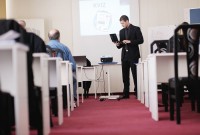- Home
- Business Processes
- Industry Knowledge
- Aerospace Industry
- Automotive Industry
- Banking Domain
- BFSI Industry
- Consumer/ FMCG Industry
- Chemicals Industry
- Engineering & Construction
- Energy Industry
- Education Domain
- Finance Domain
- Hospitality Domain
- Healthcare Industry
- Insurance Domain
- Retail Industry
- Travel and Tourism Domain
- Telecom Industry
- Leadership Skills
- eLearning
- Home
- Leadership Skills
- Career Management
- Katz’s Three-Skill Approach
Katz’s Three-Skill Approach
Robert Katz identified three leadership skills called - technical skills, human skills, and conceptual skills as the basic personal skills essential for leadership. Leaders must possess these three skills that assist them in optimizing a leader's performance. Technical skills are related to the field, human skills are related to communicating with people and conceptual skills related to setting the vision.
What is Katz Three Skill Approach?
The skills theory of leadership emerged as a prominent theory in 1955 when Robert Katz published his paper "Skills of an Effective Administrator" in the "Harvard Business Review." The research was based on Katz’s own first-hand observations of executives in the workplace and on field research in administration. He suggested in the paper that effective administration or leadership depends on three basic personal skills: technical, human, and conceptual. He identified these three skill areas as the most important skills that the executives had in common and used on a regular basis.
What are the three Skill Areas?
Katz identified three skills; technical, human, and conceptual as the basic personal skills essential for leadership. Technical skills related to the field, human skills related to communicating with people, and conceptual skills related to setting the vision.
Skill 1: Technical Skills:
As defined by Katz in 1955, ‘Technical skill is knowledge about and proficiency in a specific type of work or activity. It includes competencies in a specialized area, analytical ability, and the ability to use appropriate tools and techniques’. Technical skills play an essential role in producing the actual products a company is designed to produce. Having appropriate technical skills signifies that the person is competent and knowledgeable with respect to the activities specific to an organization, the organization’s rules and standard operating procedures, and the organization’s products and services.
Examples of Technical Skills:
For a Software Company the following skills or knowledge areas can be considered as technical skills; Knowledge of Unix/Linux Operating System, Java/C++/Perl Programming Language, MySQL/Oracle Database Management, XML - Extensible Markup Language, HTML Skills, etc.
In an accounting firm, the technical skills might include an understanding of generally accepted accounting principles, accounting principles, knowledge of commercial laws, knowledge of tax laws, etc.
Attributes of Technical Skills:
- Technical Skills refer to being knowledgeable proficient in a specific type of work or activity
- It is the ability to work with things
- Technical skill is proficiency, based on specific knowledge, in a particular area of work
- Technical skills are most important at lower and middle levels of management
- Technical skills are less important at upper/senior management levels
Skill 2: Human Skills:
As technical skills relate to the ability to working with things, similarly human skills relate to the ability to work with people. Human skills are people skills that enable the leader to work effectively with subordinates, peers, and superiors. It is the leader's expertise in interacting with others in a way that will enhance the successful completion of the task at hand. Consequently, leaders with higher levels of interpersonal skills are better able to adapt their own ideas to other people’s ideas, especially when this will aid in achieving organizational goals more quickly and efficiently. These leaders are more sensitive and empathetic to what motivates others, create an atmosphere of trust for their followers, and take others’ needs and motivations into account when deciding what to do to achieve organizational goals.
- Human skills refer to the ability to work with people
- It is being aware of one's own perspective on issues as well as the openness to hear and appreciate inputs of others on their perspectives
- Leaders adapt their own ideas incorporating good themes from those of others
- Create an atmosphere of trust where employees/followers can feel comfortable and empowered to contribute their best
- Human skills are important at all the three levels of management – Lower, Middle and Senior
Examples of Human Skills:
Some human skills that are generally considered important are effective communication (both verbal and written), motivating others, and creation a positive attitude, development of cooperation and team spirit, etc.
Skill3: Conceptual Skills:
As a leader grows higher in the organizational ladder, the expectations from him are to provide strategic direction, create the vision, and motivate the folks to dedicatedly pursue the organizational goals. These are Conceptual skills that allow the leader to think through and work with ideas. Leaders with higher levels of conceptual skills are good at thinking through the ideas that form an organization and its vision for the future.
- It is the ability to work with ideas and concepts
- Creating visions, strategic plans and setting direction
- These are cognitive, business, and strategic skills
- Ability to work easily with abstractions and hypothetical situations
- As leaders climb the career ladder, higher levels of conceptual leadership skills became necessary
- This skill is most important for top managers
- This skill is comparatively less important for middle managers
- This skill is least important for supervisory managers
- Necessary skill to climb the career ladder
Examples of Conceptual Skills:
Some conceptual skills that are generally considered important are creativity, decision making, wing to wing interconnectedness, thinking as a whole, strategic thinking, problem-solving, etc.
Advantages of Skills Approach to Leadership:
One of the major benefits of a skills-based theory of leadership is that it acknowledges that anyone can become a leader. Individuals only need to find relevant resources and work hard to develop the skills of a good leader. This is encouraging for people who are interested in gaining leadership effectiveness but do not possess the traits as proposed in other trait-based leadership theories. A skills-based leadership theory also provides a competency-based toolkit to organizations to recruit, train, and grow leaders in their organization by taking inventory of each potential leader's skills in the important areas.
Limitations of Skills Approach to Leadership:
Like other leadership models, The Skills Model also has its inherent limitations because the development of many of the skills might be dependent on personal traits, and based on individual personalities it might be easier or difficult for a person to develop certain skills. This model also focuses on identifying the skills rather than clarifying why some skills influence the leadership process.
Related Links
You May Also Like
-
Idiosyncrasy Credit Model of Leadership builds upon the awareness that when the emergent leader meets the team's expectations, idiosyncrasy credits are awarded. These credits depend on how the leader fulfilled follower's expectations and what is the impact of the leader's decisions on the follower. When the balance of credits shifts, another leader will emerge.
-
The Leader-Member Exchange Theory (LMX), also called the Vertical Dyad Linkage Theory is a relationship-based approach that focuses on the two-way (dyadic) relationship to get the best from all team members. How leaders maintain their position in groups and develop an exchange with each of their subordinates. How leaders and members develop relationships that can contribute to growth or hinder development.
-
There are four characteristics of leadership that help us to understand the character of leadership as a concept. 1. Leadership is a process, 2. Leadership involves influence, 3. Leadership always occurs in a group context and 4. Leadership involves goal attainment. These are the four components that make up the character of the 'leadership' term and help us to define the leadership concept. All of these components of leadership have common characteristics.
-
Self-Fulfilling Prophecy (SFP) Leader Theory
Pygmalion theory of Leadership is a model of SFP at work involving supervisory expectancy based on the pygmalion effect. This effect is a type of self-fulfilling prophecy (SFP) in which raising leader's expectations regarding subordinate performance boosts the group's performance. Managers who are led to demand more from their team, lead the team to better performance. There is some evidence that the SFP effect does exists.
-
Early studies on leadership were done at Ohio State University using the Leader Behavior Description Questionnaire to identify the leader's observable behaviors. Ohio State study on leadership found two behavioral characteristics of leadership - people-oriented (consideration) and task-oriented (initiating structure) leadership style.
-
The ten most important qualities that define a good leader are self-awareness, interpersonal and communication skills, ethical values, organizational consciousness, self-confidence, adaptability and flexibility, imagination and creativity, focus & result-orientation, continuous self-development and accountability and ownership for his actions. These ten qualities of leadership every good leader should possess to a certain extent and must continually strive to develop them.
-
Jung first introduced his personality theory and explained that all humans have a natural impulse to relate meaningfully to the world through productive work and people through significant relationships. He used four psychological functions - thinking and feeling (rational functions) and sensation and intuition (irrational functions). He also used introversion and extraversion and its impact on appropriate leader behaviors.
-
Rensis Likert studied the patterns and styles of managers and developed four management systems known as Likert's management systems. These styles developed by him are known as Likert management systems. System 1 - Exploitative Authoritative; System 2 - Benevolent Authoritative; System 3 - Consultative and System 4 - Participative.
-
Bass's Transformational Leadership Theory
Bass Transformational Leadership Theory is based on performance beyond expectations approach which defines four elements of transformational leadership. The 4 elements described by Bernard A. Bass in 1985 are Idealised Influence, Intellectual Stimulation, Individualised Consideration, and Inspirational Motivation. This study highlights four key insights about performance beyond expectations and associated criteria to measure it.
-
Robert Katz identified three leadership skills called - technical skills, human skills, and conceptual skills as the basic personal skills essential for leadership. Leaders must possess these three skills that assist them in optimizing a leader's performance. Technical skills are related to the field, human skills are related to communicating with people and conceptual skills related to setting the vision.
Explore Our Free Training Articles or
Sign Up to Start With Our eLearning Courses

About Us
Learning
© 2023 TechnoFunc, All Rights Reserved










